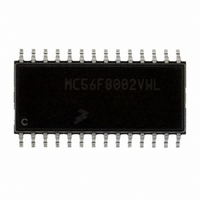MC56F8002VWL Freescale Semiconductor, MC56F8002VWL Datasheet - Page 39

MC56F8002VWL
Manufacturer Part Number
MC56F8002VWL
Description
DSC 12K FLASH 32MHZ 28-SOIC
Manufacturer
Freescale Semiconductor
Series
56F8xxxr
Datasheet
1.MC56F8006DEMO.pdf
(100 pages)
Specifications of MC56F8002VWL
Core Processor
56800
Core Size
16-Bit
Speed
32MHz
Connectivity
I²C, LIN, SCI, SPI
Peripherals
LVD, POR, PWM, WDT
Number Of I /o
23
Program Memory Size
12KB (6K x 16)
Program Memory Type
FLASH
Ram Size
1K x 16
Voltage - Supply (vcc/vdd)
1.8 V ~ 3.6 V
Data Converters
A/D 15x12b
Oscillator Type
Internal
Operating Temperature
-40°C ~ 105°C
Package / Case
28-SOIC
Product
DSCs
Data Bus Width
16 bit
Processor Series
MC56F80xx
Core
56800E
Instruction Set Architecture
Dual Harvard
Device Million Instructions Per Second
32 MIPs
Maximum Clock Frequency
32 MHz
Number Of Programmable I/os
40
Data Ram Size
2 KB
Operating Supply Voltage
1.8 V to 3.6 V
Maximum Operating Temperature
+ 105 C
Mounting Style
SMD/SMT
Development Tools By Supplier
MC56F8006DEMO, APMOTOR56F8000E
Interface Type
LIN, I2C, SCI, SPI
Minimum Operating Temperature
- 40 C
For Use With
APMOTOR56F8000E - KIT DEMO MOTOR CTRL SYSTEM
Lead Free Status / RoHS Status
Lead free / RoHS Compliant
Eeprom Size
-
Lead Free Status / Rohs Status
Lead free / RoHS Compliant
Available stocks
Company
Part Number
Manufacturer
Quantity
Price
Part Number:
MC56F8002VWL
Manufacturer:
FREESCALE
Quantity:
20 000
application software could communicate over a serial port, for example, to validate the authenticity of the requested access, then
grant it until the next device reset. The inclusion of such a back door technique is at the discretion of the system designer.
7.1
After you have programmed flash with the application code, or as part of the programming of the flash with the application
code, the 56F8006/56F8002 can be secured by programming the security word, 0x0002, into program memory location 0x00
1FF7. This can also be effected by use of the CodeWarrior IDE menu flash lock command. This nonvolatile word keeps the
device secured after reset, caused, for example, by a power-down of the device. Refer to the flash memory chapter in the
MC56F8006 Peripheral Reference Manual for detail. When flash security mode is enabled, the 56F8006/56F8002 disables the
core EOnCE debug capabilities. Normal program execution is otherwise unaffected.
7.2
There are several methods that effectively lock or unlock the on-chip flash.
7.2.1
On-chip flash can be read by issuing commands across the EOnCE port, which is the debug interface for the 56800E CPU. The
TCK, TMS, TDO, and TDI pins comprise a JTAG interface onto which the EOnCE port functionality is mapped. When the
device boots, the chip-level JTAG TAP (test access port) is active and provides the chip’s boundary scan capability and access
to the ID register, but proper implementation of flash security blocks any attempt to access the internal flash memory via the
EOnCE port when security is enabled. This protection is effective when the device comes out of reset, even prior to the
execution of any code at startup.
7.2.2
If the device is secured, one lockout recovery mechanism is the complete erasure of the internal flash contents, including the
configuration field, thus disabling security (the protection register is cleared). This does not compromise security, as the entire
contents of your secured code stored in flash are erased before security is disabled on the device on the next reset or power-up
sequence.
To start the lockout recovery sequence via JTAG, the JTAG public instruction (LOCKOUT_RECOVERY) must first be shifted
into the chip-level TAP controller’s instruction register. After the LOCKOUT_RECOVERY instruction has been shifted into
the instruction register, the clock divider value must be shifted into the corresponding 7-bit data register. After the data register
has been updated, you must transition the TAP controller into the RUN-TEST/IDLE state for the lockout sequence to
commence. The controller must remain in this state until the erase sequence is complete. Refer to the MC56F8006 Peripheral
Reference Manual for detail, or contact Freescale.
7.2.3
CodeWarrior can unlock a device by selecting the Debug menu, then selecting DSP56800E, followed by Unlock Flash. Another
mechanism is also built into CodeWarrior using the device’s memory configuration file. The command
“Unlock_Flash_on_Connect 1” in the .cfg file accomplishes the same task as using the Debug menu.
This lockout recovery mechanism is the complete erasure of the internal flash contents, including the configuration field, thus
disabling security (the protection register is cleared).
Freescale Semiconductor
Operation with Security Enabled
Flash Access Lock and Unlock Mechanisms
Disabling EOnCE Access
Flash Lockout Recovery Using JTAG
Flash Lockout Recovery Using CodeWarrior
After the lockout recovery sequence has completed, you must reset the JTAG TAP
controller and device to return to normal unsecured operation. Power-on reset resets both
too.
MC56F8006/MC56F8002 Digital Signal Controller, Rev. 3
NOTE
Security Features
39











